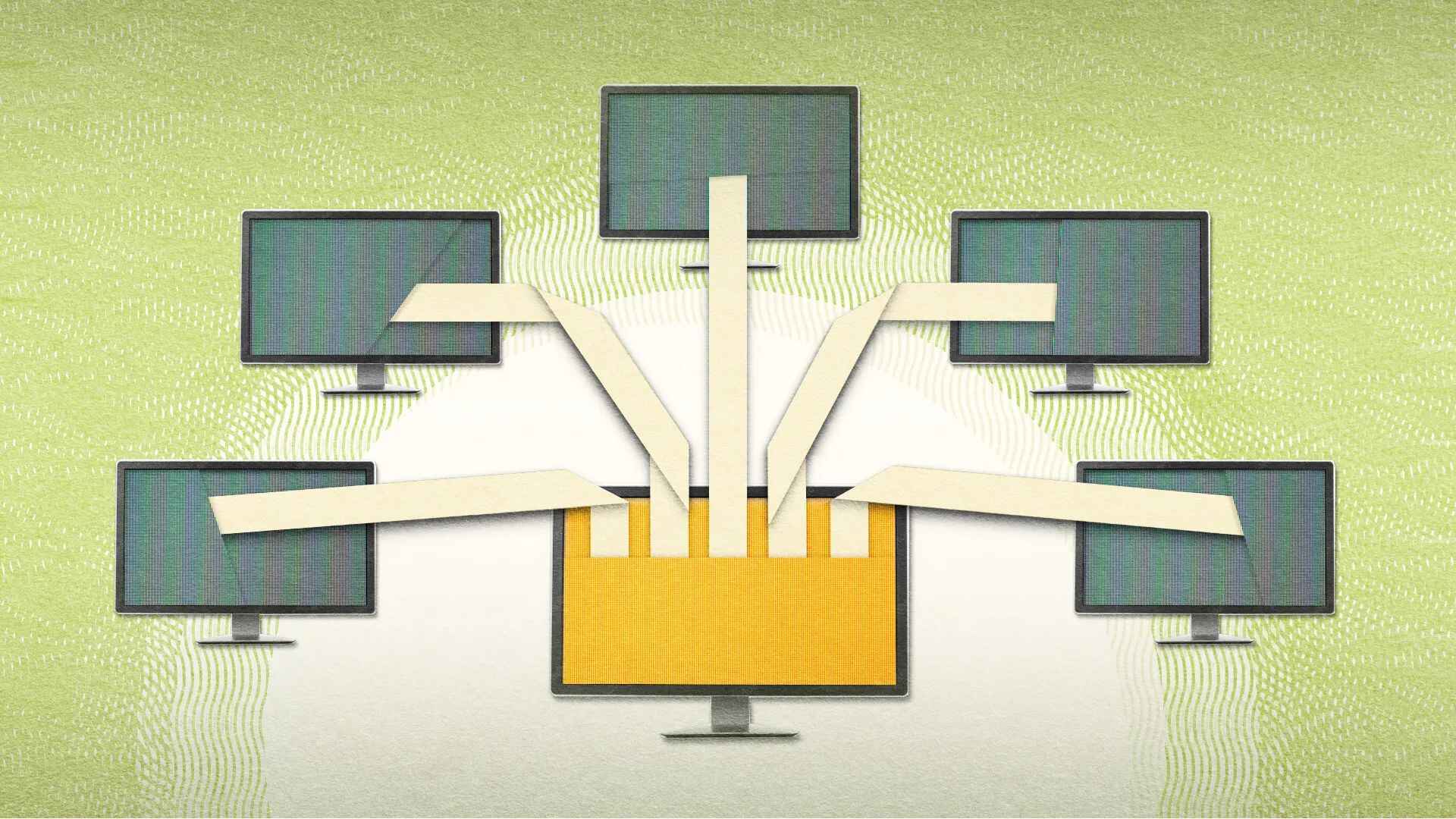Introduction
The rise of technology has revolutionized various industries, transforming the way we live, work, and interact with one another. Among the many technological advancements, blockchain has emerged as a disruptive force with the potential to revolutionize numerous sectors.
Blockchain technology, initially introduced as the underlying technology for cryptocurrencies, has gained widespread attention due to its secure, transparent, and decentralized nature. It has the potential to redefine the way we conduct transactions, verify information, and establish trust in various domains.
But what exactly is blockchain? How does it work? And what are its key features and benefits? In this article, we will provide a comprehensive overview of blockchain technology, exploring its various applications, limitations, and its future potential.
At its core, blockchain can be defined as a decentralized and distributed ledger technology that securely records and verifies transactions across a network of computers. Unlike traditional central authorities, such as banks or government institutions, blockchain relies on consensus algorithms and cryptographic techniques to ensure the integrity and immutability of the recorded data.
Blockchain technology operates on the principle of a chain of blocks that contains transactional data. Each block is linked to the previous one through a hash function and timestamp, forming a chronological and tamper-proof record of information. This decentralized structure eliminates the need for intermediaries, reduces the risk of fraud, and enhances transparency and accountability.
Blockchain has gained recognition primarily due to its association with cryptocurrencies, especially Bitcoin. However, its potential extends far beyond digital currencies. Blockchain technology can be applied across various industries, including finance, supply chain management, healthcare, real estate, and more.
By leveraging the power of blockchain, organizations can streamline processes, eliminate intermediaries, reduce costs, enhance security, and establish trust. The immutable nature of the technology ensures that once a transaction is recorded, it cannot be altered or deleted, providing a high level of data integrity.
Despite its many advantages, blockchain technology also faces certain challenges and limitations. The scalability issue, energy consumption, regulatory concerns, and the need for widespread adoption are some of the barriers that need to be addressed for blockchain to reach its full potential.
As we explore the intricate world of blockchain technology, it is important to understand its key features, such as decentralization, transparency, security, and immutability, and its potential to disrupt industries and transform the way we interact and do business.
Definition of Blockchain
Blockchain is a decentralized and distributed digital ledger that records transactions across multiple computers or nodes in a network. It serves as a tamper-proof and transparent record of information, ensuring the integrity and immutability of data.
At its core, a blockchain is composed of a chain of blocks, where each block contains a list of transactions. These transactions are digitally signed and verified by participants in the network through consensus algorithms. Once a block is verified, it is added to the chain, creating a permanent and unchangeable history of transactions.
One of the key aspects of blockchain technology is its decentralized nature. Unlike traditional centralized systems where a single entity controls the data, blockchain operates on a peer-to-peer network, with each participant (or node) having a copy of the entire blockchain. This eliminates the need for a central authority, such as a bank or government, and allows for greater transparency and trust among participants.
The security of blockchain is maintained through its cryptographic techniques. Each transaction within a block is secured using cryptographic hashes, which are unique digital signatures that ensure the integrity and authenticity of the data. Once a block is added to the chain, it becomes extremely difficult to alter previous transactions, as it would require changing the entire subsequent chain.
Immutability is another fundamental characteristic of blockchain. Once a transaction is recorded on the blockchain, it cannot be altered or deleted, providing a permanent and auditable record. This feature enhances the transparency and accountability of transactions, as every participant in the network can verify the history of the blockchain and ensure the accuracy of the information.
While blockchain technology gained prominence through its association with cryptocurrencies like Bitcoin, its applications are not limited to digital currencies. Blockchain can be utilized in various industries to streamline processes, reduce costs, enhance security, and establish trust. From supply chain management to healthcare records, blockchain has the potential to revolutionize multiple sectors.
In summary, blockchain is a decentralized and distributed digital ledger that securely records transactions across a network. Its key features of decentralization, transparency, security, and immutability make it a valuable technology with numerous applications. By harnessing the power of blockchain, organizations can transform the way they conduct transactions and build trust in today’s digital age.
How Does Blockchain Work?
Understanding how blockchain works requires delving into its underlying processes and components. At its core, blockchain operates on a decentralized network, where transactions are verified, recorded, and added to a chain of blocks.
The blockchain network consists of multiple nodes, which are computers or devices that participate in the verification and validation of transactions. These nodes work together to maintain the integrity and security of the blockchain network.
When a transaction is initiated, it is broadcasted to the entire network. Each node in the network receives the transaction and performs a series of checks to ensure its validity. These checks include verifying the digital signatures, confirming that the sender has sufficient funds, and ensuring that the transaction adheres to the predefined rules and protocols.
Once a consensus is reached among the nodes that the transaction is valid, it is grouped together with other transactions and formed into a block. Each block contains a unique identifier, a timestamp, and a reference to the previous block in the chain, forming a continuous and chronological record.
Before a block is added to the blockchain, it undergoes a process called mining. Mining involves solving complex mathematical puzzles to validate the transactions within the block. Miners compete against each other to find a solution, which requires a significant amount of computational power and energy. The first miner to solve the puzzle and find a valid solution is rewarded with newly created cryptocurrency tokens, incentivizing them to continue mining.
Once a valid solution is found by a miner, the block is added to the blockchain, and the information in the block becomes permanent and unchangeable. The decentralized nature of the blockchain network ensures that all nodes have a copy of the updated blockchain, validating the integrity and consistency of the data.
To maintain the security and immutability of the blockchain, altering a transaction or block becomes extremely difficult. Changing the information in a block would require modifying all subsequent blocks in the chain, which would require the consensus and computational power of the majority of nodes in the network. This makes the blockchain highly resistant to tampering and ensures the trustworthiness of the recorded data.
Overall, the process of how blockchain works involves transaction broadcasting, validation by consensus, grouping transactions into blocks, solving cryptographic puzzles through mining, and adding verified blocks to the blockchain, creating a secure, transparent, and decentralized ledger.
Key Features of Blockchain
Blockchain technology offers several key features that make it a unique and powerful tool for various industries. Understanding these features is crucial in comprehending the potential impact of blockchain and how it can reshape traditional systems and processes.
Decentralization: One of the defining characteristics of blockchain is its decentralized nature. Unlike traditional systems that rely on a central authority, blockchain operates on a peer-to-peer network of nodes, where each participant has a copy of the entire blockchain. This decentralization eliminates the need for intermediaries, reduces the risk of a single point of failure, and promotes trust among participants.
Transparency: Blockchain provides transparency by enabling all participants in the network to have visibility into the transactions recorded on the blockchain. Since every transaction is added to a block and linked to a previous one, the entire transaction history is readily available for verification. This transparency enhances trust and accountability, as any participant can independently verify the accuracy and integrity of the information.
Security: Blockchain ensures security through the use of advanced cryptographic techniques. Each transaction is encrypted, and the digital signatures are verified by every node in the network. The decentralized nature of blockchain also makes it highly resistant to hacking and fraud attempts, as an attacker would need to gain control of the majority of nodes to tamper with the data.
Immutability: Once a transaction is recorded on the blockchain, it becomes virtually impossible to alter or delete. The structure of the blockchain, with each block linking to the previous one using cryptographic hashes, ensures the immutability of the data. This immutability enhances the integrity of records, prevents fraudulent activities, and provides a reliable historical trail of transactions.
Efficiency and Speed: Blockchain has the potential to streamline processes and increase efficiency by removing intermediaries and automating trust mechanisms. Since blockchain operates on a distributed network, there is no need to rely on a central authority to verify transactions, resulting in faster and more efficient transactions.
Cost Reduction: By eliminating intermediaries, reducing paperwork, and automating processes, blockchain has the potential to significantly reduce costs. Organizations can save on transaction fees, operational expenses, and auditing costs, leading to more cost-effective operations.
Scalability: While scalability has been a challenge for blockchain technology, advancements such as sharding and layer-2 solutions are being developed to address this issue. These solutions aim to increase the capacity of blockchain networks, allowing for a larger number of transactions to be processed quickly and efficiently.
Overall, the key features of blockchain, including decentralization, transparency, security, immutability, efficiency, cost reduction, and scalability, make it a compelling technology with the potential to transform various industries and usher in a new era of trust, transparency, and efficiency.
Types of Blockchains
Blockchains can be categorized into different types based on their accessibility, governance models, and permission levels. Each type of blockchain offers unique advantages and is suitable for specific use cases. Let’s explore some of the common types of blockchains:
Public Blockchains: Public blockchains are open to anyone and allow for permissionless participation. These blockchains, such as Bitcoin and Ethereum, are decentralized networks where anyone can join, validate transactions, and contribute to the consensus mechanism. Public blockchains provide transparency, security, and immutability, making them suitable for applications that require trust and openness.
Private Blockchains: Private blockchains, also called permissioned blockchains, are restricted to a specific group of participants. Unlike public blockchains, private blockchains are controlled by a central authority or a consortium of trusted entities. Private blockchains are often used in business settings where privacy and control are essential, allowing organizations to collaborate securely while maintaining confidentiality.
Consortium Blockchains: Consortium blockchains are a hybrid model that combines features of both public and private blockchains. In a consortium blockchain, several organizations or entities come together to collectively govern and validate transactions. Consortium blockchains offer a balance between decentralization and control, enabling collaboration among a group of trusted participants.
Hybrid Blockchains: Hybrid blockchains combine elements of both public and private blockchains, allowing for greater flexibility and customization. These blockchains may have both public and private layers, where public transactions are visible to all participants, while private transactions are restricted to specific parties. Hybrid blockchains can cater to diverse use cases, providing a blend of openness and privacy.
Permissioned Blockchains: Permissioned blockchains require participants to obtain permission or be granted access by a central authority before joining the network. These blockchains are often used in enterprise settings, where strict control over network participants and data access is required. Permissioned blockchains can offer high scalability and transaction throughput while ensuring data privacy and security.
Sidechains: Sidechains are separate blockchains that are connected to a main blockchain through two-way pegging. Sidechains enable the execution of smart contracts or the development of specific applications with different functionalities without congesting the main blockchain. They allow for interoperability and scalability while maintaining the security and trust of the main blockchain.
The choice of blockchain type depends on the specific requirements of an application or organization. Public blockchains offer openness and security, while private and consortium blockchains provide greater control and privacy. Hybrid and permissioned blockchains offer flexibility and customization, catering to specific use cases. Understanding the different types of blockchains enables organizations to select the most suitable blockchain architecture to meet their needs.
Benefits of Using Blockchain Technology
Blockchain technology offers a range of benefits that can revolutionize various industries and transform the way we conduct transactions, store data, and establish trust. Let’s explore some of the key advantages of using blockchain:
Enhanced Security: Blockchain provides enhanced security measures through cryptographic techniques and decentralized networks. Transactions recorded on the blockchain are encrypted and linked to previous transactions using a chain of blocks, making it extremely difficult for hackers to modify or tamper with the data. The decentralized nature of blockchain also eliminates the risk of a single point of failure, making it more secure compared to centralized systems.
Transparency and Trust: Blockchain promotes transparency by offering a public ledger where all transactions are visible to participants in the network. This transparency enhances trust as users can independently verify and audit the information stored on the blockchain. It eliminates the need for intermediaries in trust-based transactions, reducing the risk of fraud and promoting accountability.
Efficiency and Cost Reduction: By eliminating intermediaries and automating processes, blockchain technology can greatly reduce transaction costs and increase efficiency. Blockchain allows for faster, streamlined, and more accurate transactions without the need for complex reconciliations or manual verifications. It simplifies paperwork, reduces administrative tasks, and minimizes errors, resulting in cost savings for businesses.
Data Integrity and Immutability: Blockchain ensures the integrity and immutability of data once it is recorded on the blockchain. Every transaction is permanently recorded and linked to previous transactions, creating an auditable trail of information. This immutability prevents unauthorized alterations, fraud, and tampering, providing a reliable and transparent source of truth.
Improved Traceability: With blockchain, organizations can achieve enhanced traceability of goods and assets throughout supply chains. Each transaction recorded on the blockchain can be traced back to its origin, providing a transparent and immutable history of ownership, transfers, and interactions. This feature is particularly valuable in industries such as logistics, food safety, and provenance verification.
Decentralization and Resilience: Blockchain operates on a decentralized network of nodes, making it highly resilient to failures and attacks. The distributed nature of blockchain ensures that even if one or multiple nodes fail, the network continues to function without interruption. This resilience contributes to the overall stability and reliability of the blockchain infrastructure.
Streamlined Compliance: Blockchain can streamline compliance processes by enabling the secure and transparent sharing of data among participants. By automating compliance and regulatory requirements, blockchain reduces the administrative burden and facilitates faster and more efficient audits.
Increased Financial Inclusion: Blockchain technology has the potential to promote financial inclusion by providing access to financial services to the unbanked or underbanked populations. With blockchain-based digital identities and decentralized financial systems, individuals in remote and underserved areas can access financial services, transfer funds, and participate in the global economy.
Overall, blockchain technology offers numerous benefits, including enhanced security, transparency, efficiency, data integrity, and traceability. It has the potential to revolutionize industries, streamline processes, and empower individuals and organizations to build trust and conduct transactions in a more efficient and secure manner.
Applications of Blockchain
Blockchain technology is finding applications across a wide range of industries and sectors, transforming traditional systems and processes. Let’s explore some of the key areas where blockchain is being implemented:
Finance and Banking: One of the prominent applications of blockchain is in the financial industry. Blockchain can enable faster and more secure cross-border payments, eliminate intermediaries in the remittance process, and provide a transparent and auditable ledger for financial transactions. Smart contracts, powered by blockchain, can automate processes such as loan approvals and insurance claims, reducing paperwork and increasing efficiency.
Supply Chain Management: Blockchain has the potential to revolutionize supply chain management by enhancing transparency and traceability. It enables end-to-end visibility of the supply chain, enabling real-time tracking of goods, verifying product authenticity, and ensuring compliance with regulations. Blockchain-based supply chain solutions can help prevent fraud, reduce counterfeit products, and optimize inventory management.
Healthcare: Blockchain technology can transform the healthcare industry by securely storing and sharing patient data. It allows for the creation of a decentralized and interoperable electronic health record system, improving data accuracy and accessibility. Blockchain can also facilitate medical research by securely sharing anonymized patient data and tracking the authenticity of pharmaceutical products.
Real Estate: Blockchain can streamline real estate transactions by automating property transfers, eliminating the need for intermediaries, and reducing paperwork. Smart contracts on the blockchain can verify the authenticity of property titles, streamline the purchasing process, enable fractional ownership, and enhance transparency in property transactions.
Identity Management: Blockchain-based identity management systems offer secure and decentralized digital identities. By storing identity information on the blockchain, individuals have control over their personal data and can selectively share it with trusted parties. Identity verification becomes more efficient, reducing identity theft and fraud.
Energy and Utilities: Blockchain technology can disrupt the energy sector by enabling peer-to-peer energy trading, optimizing energy distribution, and enhancing grid management. With blockchain, renewable energy producers can sell excess energy directly to consumers, bypassing traditional energy providers and reducing costs. Blockchain can also enable the tracking of energy consumption and facilitate energy credits and incentives.
Education: Blockchain can play a role in the education industry by securely storing and verifying academic credentials. It allows for the creation of tamper-proof digital records of achievements, certifications, and qualifications. With blockchain, employers can easily verify the authenticity of educational qualifications, reducing the risk of credential fraud.
These are just some of the many applications of blockchain technology. As the technology continues to evolve and mature, new use cases and industries will emerge, leading to further disruption and innovation.
Challenges and Limitations of Blockchain Technology
While blockchain technology holds immense potential, there are several challenges and limitations that need to be addressed for its widespread adoption. Let’s explore some of the key obstacles:
Scalability: Blockchain faces scalability challenges when it comes to processing a large number of transactions. The current consensus mechanisms and design of most blockchain networks make it difficult to achieve the transaction throughput required by high-demand applications. Solutions such as sharding and layer-2 protocols are being developed to address this issue.
Energy Consumption: The energy consumption associated with mining and validating transactions on blockchain networks, particularly proof-of-work (PoW) mechanisms, is a significant concern. The computational power required for mining consumes a considerable amount of electricity, leading to environmental concerns. The development of more energy-efficient consensus mechanisms is an ongoing area of research.
Regulatory and Legal Challenges: The regulatory landscape surrounding blockchain technology is still evolving. The decentralized and cross-border nature of blockchain poses challenges in terms of compliance with existing regulations. Governments and regulatory bodies are working to establish frameworks to address issues such as data privacy, digital identity, and smart contracts.
Interoperability: Interoperability between different blockchain networks and systems is a key challenge. As there are numerous blockchain platforms with varying protocols and standards, achieving seamless interoperability and data exchange among them proves to be complex. Standards and protocols for cross-chain communication are being developed to address this limitation.
User Adoption: Blockchain technology is still relatively new and unfamiliar to many users. The complexity of blockchain networks and the need for technical understanding can hinder user adoption. User-friendly interfaces, educational initiatives, and greater awareness are required to make blockchain accessible to a wider audience.
Privacy Concerns: While blockchain provides transparency and immutability, it also presents challenges regarding privacy. Public blockchains store transaction data that is visible to all participants, raising concerns about the exposure of sensitive information. Privacy-focused solutions such as zero-knowledge proofs and privacy-preserving smart contracts are being developed to address these concerns.
Cost and Infrastructure: Implementing blockchain technology can involve significant upfront costs, including infrastructure, development, and maintenance expenses. The need for secure and robust blockchain networks requires adequate investment in hardware, software, and skilled personnel. Additionally, legacy systems and infrastructure might need to be adapted or integrated with blockchain, which can be a complex and costly process.
It is important to recognize and address these challenges and limitations to ensure the continued growth and adoption of blockchain technology. Research, innovation, collaboration, and the development of standards and regulations will play a crucial role in overcoming these obstacles and unlocking the full potential of blockchain.
Future of Blockchain Technology
The future of blockchain technology holds immense promise and potential for disruption across various industries. As the technology continues to evolve and mature, several trends and advancements point to an exciting future ahead:
Enterprise Adoption: The adoption of blockchain technology by enterprises is expected to increase significantly in the coming years. Organizations are recognizing the benefits of blockchain in enhancing efficiency, reducing costs, and improving transparency. As more use cases and success stories emerge, businesses are likely to integrate blockchain into their operations, leading to widespread adoption.
Interoperability and Standardization: Efforts are underway to improve interoperability and standardization among different blockchain platforms. Interoperability solutions, such as cross-chain protocols and interoperability frameworks, will enable seamless communication and data exchange between various blockchains. Standards and protocols will help ensure compatibility and interoperability, fostering a network effect and encouraging collaboration.
Integration with Emerging Technologies: Blockchain is expected to integrate with other emerging technologies, such as Internet of Things (IoT), artificial intelligence (AI), and machine learning (ML). These synergies will create new opportunities and applications, such as secure and decentralized IoT networks, AI-powered smart contracts, and blockchain-based data marketplaces.
Improved Scalability and Performance: Scalability and performance limitations of blockchain networks are being addressed through advancements in consensus mechanisms and layer-2 solutions. Developments like sharding, off-chain transactions, and sidechains will enhance the scalability and transaction throughput of blockchain, enabling it to handle a larger volume of transactions in a faster and more efficient manner.
Increased Privacy and Confidentiality: Solutions for privacy and confidentiality on public blockchains are being developed to address concerns surrounding sensitive data exposure. Techniques like zero-knowledge proofs and secure multi-party computation will enable privacy-preserving transactions and confidential smart contracts, making blockchain more appealing to enterprises handling sensitive information.
Central Bank Digital Currencies: Central banks worldwide are exploring the concept of central bank digital currencies (CBDCs) built on blockchain technology. CBDCs have the potential to revolutionize the financial system by providing secure, transparent, and efficient digital forms of national currencies, while preserving the stability and trust associated with central bank governance.
Sustainable and Green Solutions: The environmental impact of blockchain’s energy consumption is a growing concern. In the future, there will be a focus on creating more sustainable and energy-efficient consensus mechanisms. The development of proof-of-stake (PoS) and other eco-friendly approaches will reduce the carbon footprint of blockchain networks.
Decentralized Finance (DeFi) and Web 3.0: The rise of decentralized finance (DeFi) applications and the concept of Web 3.0 are reshaping the financial landscape. DeFi platforms built on blockchain enable peer-to-peer lending, decentralized exchanges, and other financial services without intermediaries. This decentralized and permissionless ecosystem has the potential to disrupt traditional financial systems and empower individuals.
The future of blockchain technology is filled with possibilities and transformative potential. As the technology continues to mature, the integration of blockchain with emerging technologies, the development of interoperability standards, and the focus on scalability, privacy, and sustainability will shape a future where blockchain becomes an integral part of our everyday lives.
Conclusion
Blockchain technology has emerged as a game-changer, offering decentralized, transparent, and secure solutions to various industries. The potential of blockchain goes beyond cryptocurrencies, reaching sectors like finance, supply chain management, healthcare, and more. As we’ve explored throughout this article, blockchain offers key features such as decentralization, transparency, security, immutability, and efficiency, which can revolutionize traditional systems and processes.
Despite the challenges and limitations it faces, blockchain technology continues to evolve and innovate. Efforts are being made to address scalability, energy consumption, regulatory concerns, interoperability, and privacy issues. The future of blockchain looks promising, with trends such as increased enterprise adoption, interoperability, integration with emerging technologies, and the development of sustainable solutions paving the way for widespread implementation.
As blockchain technology advances, it is crucial to continue exploring its applications and potential use cases. From streamlining financial transactions to enabling secure supply chain management, blockchain has the power to improve efficiency, reduce costs, increase transparency, and establish trust in various sectors.
However, to fully realize the benefits of blockchain, collaboration between industry players, governments, and regulatory bodies is vital. Developing common standards, frameworks, and regulations will foster adoption, ensure compatibility, and address legal and compliance challenges.
In conclusion, blockchain technology is poised to revolutionize industries and reshape the way we conduct transactions, store data, and establish trust. With ongoing research, innovation, and collaboration, blockchain has the potential to transform our digital world, empower individuals, enhance security, and provide new opportunities for economic growth and development.

























